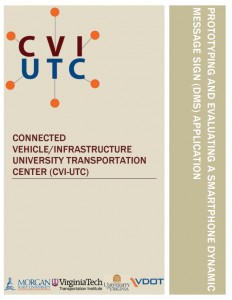The final report for Prototyping and Evaluating a Smart Phone Dynamic Message Sign Application in the CVI-UTC Testbed, submitted by Dr. Brian L. Smith, Dr. Jiaqi Ma, and Dr. Hyungjun Park, has been released.
Traveler Information Systems are designed and operated by transportation agencies to provide travelers with real-time traffic information, enabling them to make better travel decisions. One of the most commonly used ways to provide real-time, en route traveler information to motorists is through Dynamic Message Signs (DMSs). Despite their effectiveness, they are costly and limited in terms of the amount of information they can deliver. The wide availability of smart mobile devices can provide traveler information through in-vehicle devices (without incurring huge infrastructure costs) and (in a more flexible manner) to selected individuals and locations without geographical constraints. Research was conducted to comprehensively develop and evaluate this concept and a summary of tasks and findings is presented below.
First, this research proposed the concept of a Virtual Dynamic Message Sign (VDMS) system utilizing a smartphone-based application to demonstrate and summarize user experience for future deployment. The user survey revealed a positive attitude among participants toward a VDMS system in terms of both usefulness and satisfaction; the average ratings were −0.90 and −0.81 respectively on a −2 to 2 (Totally agree to Totally disagree) five-point Likert scale. The survey also indicated that most drivers (81.0%) perceived VDMS as a safer way to receive information. Many drivers (66.7%) also felt more comfortable receiving an audible message from a VDMS system rather than a text message on a DMS. The results indicate great user acceptability and the potential for such systems to be deployed by public agencies in the future.
This research also aimed to address the question of whether a VDMS conveys information at least as effectively as existing DMSs. A mixed, repeated-measure experiment was designed using a driver simulator to examine (1) the impacts of driver age, (2) information transmission mode, (3) amount of information, and (4) driving complexity on message comprehension, distraction, and perceived difficulty.
Forty-two people were recruited and each of them participated in a test under different combinations. Participant performance was measured in terms of message comprehension, distraction, and self-reported message difficulty level. Results revealed that VDMS generally performs better than DMS across different amounts of information, under different driving conditions, and regardless of driver age. VDMS proved significantly better than DMS in message comprehension under relatively complex conditions. It reduced reaction time to unexpected stimuli (as measured with a reduced time-to-brake of 0.39 seconds), and made the same messages easier to process and retain for drivers than DMS.
Based on these results, it is recommended that transportation agencies give careful consideration to VDMS as a future strategy for delivering public traffic information in a connected vehicle environment.
Click here to learn more about this project and read the final report.
